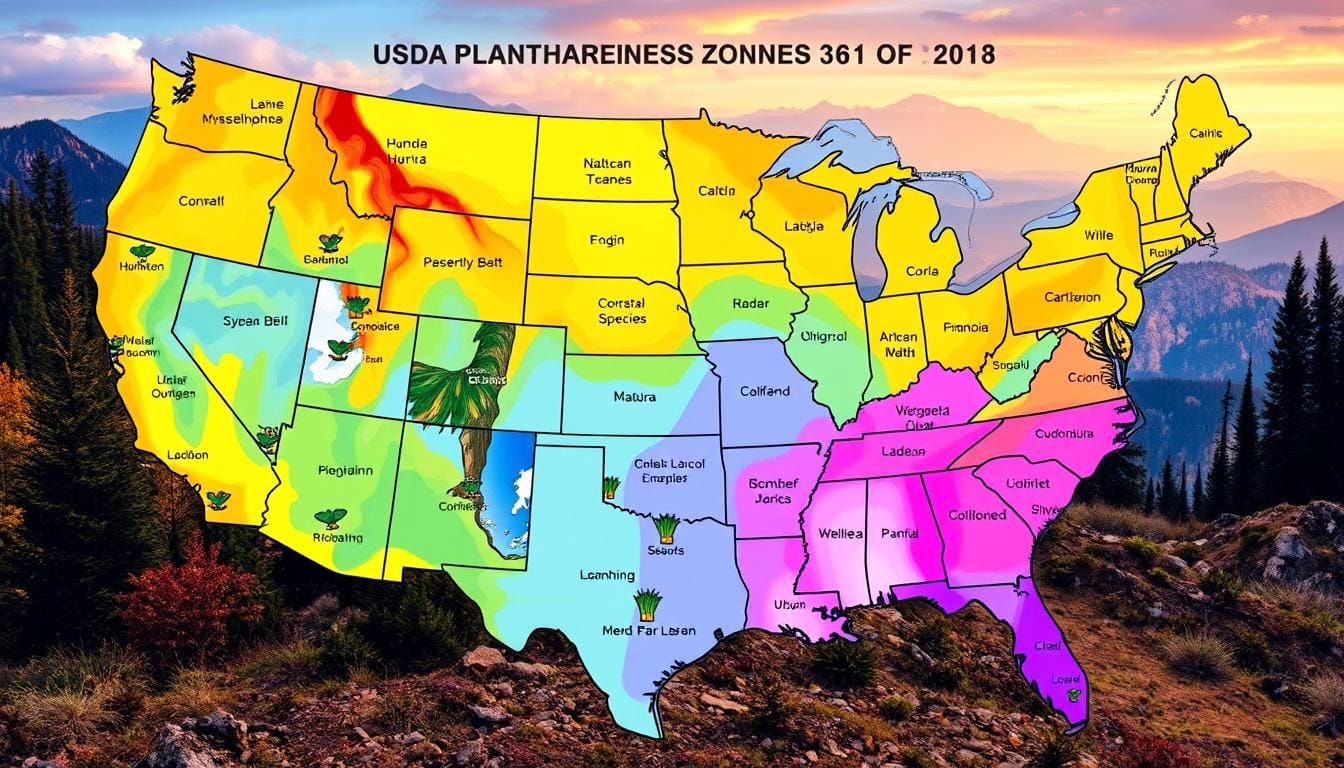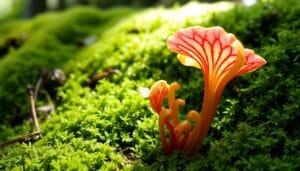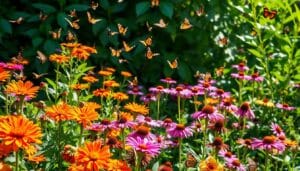Gardening fans need to know about plant hardiness to grow a great garden. The USDA Plant Hardiness Zone Map shows North America in 13 zones. Each zone is 10 degrees different in average winter temperature. This map helps pick plants that can handle your local weather and grow well.
Knowing about plant hardiness is key to a good garden. This guide will cover what affects plant survival, the USDA’s zone system, and how to choose the right plants for your area. By learning about plant hardiness, you can create a garden that’s both beautiful and easy to care for, matching your local environment perfectly.
Key Takeaways
- The USDA Plant Hardiness Zone Map divides North America into 13 distinct zones based on average annual minimum temperatures.
- Each hardiness zone represents a 10-degree temperature difference, with further subdivisions into “a” and “b” segments for more precise planting guidance.
- Elevation and other environmental factors can significantly impact the hardiness zone of a given area, requiring on-site observations to complement the zoning system.
- Selecting plants suited to your hardiness zone is crucial for ensuring their survival and optimal growth, as planting outside the recommended zone can lead to reduced performance or even plant death.
- Understanding plant hardiness is a fundamental step in creating a thriving, low-maintenance garden that is tailored to your local climate and ecosystem.
What Is Plant Hardiness and Why It Matters
Plant hardiness is key to picking the right plants for your area. It helps gardeners pick perennials, trees, and shrubs that can handle local winters. This ensures they grow well year after year. The USDA or Sunset zones are great guides, but your garden’s microclimate also matters.
Defining Plant Cold Tolerance
Plant hardiness is about how well plants handle cold, especially in winter. Frost resistance plants and winter-hardy varieties can take harsh weather better. Climate adaptation plants do well in many climates.
Impact on Garden Planning
Knowing about plant hardiness is vital for planning your garden. It’s especially important for choosing perennials and woody plants. The right plants for your climate can make your garden flourish or just barely survive.
Survival Rates in Different Climates
The USDA Plant Hardiness Zone Map breaks the US and Canada into 11 zones by winter temperature. This map is a big help for gardeners. It shows which plants will likely do well in your area, making your investment in frost resistance plants, winter-hardy varieties, and climate adaptation plants worthwhile.
“Planting a cold hardy perennial in a zone that is warmer than the designated range may result in a lack of vigor, flowers, and fruit setting.”
Understanding plant hardiness lets gardeners create beautiful, lasting landscapes. This knowledge helps them make smart choices. It leads to gardens that are not just beautiful but also sustainable and bring joy to their lives.
The USDA Plant Hardiness Zone Map Explained
The USDA Plant Hardiness Zone Map is a key tool for gardeners. It shows which areas are best for growing plants. The map splits North America into 13 USDA zones, based on winter temperatures.
These zones range from Zone 1, the coldest, to Zone 13, the warmest. Each zone is split into “a” and “b” subzones, showing a 5°F (2.8°C) temperature difference. This helps gardeners choose the right plants for their climate.
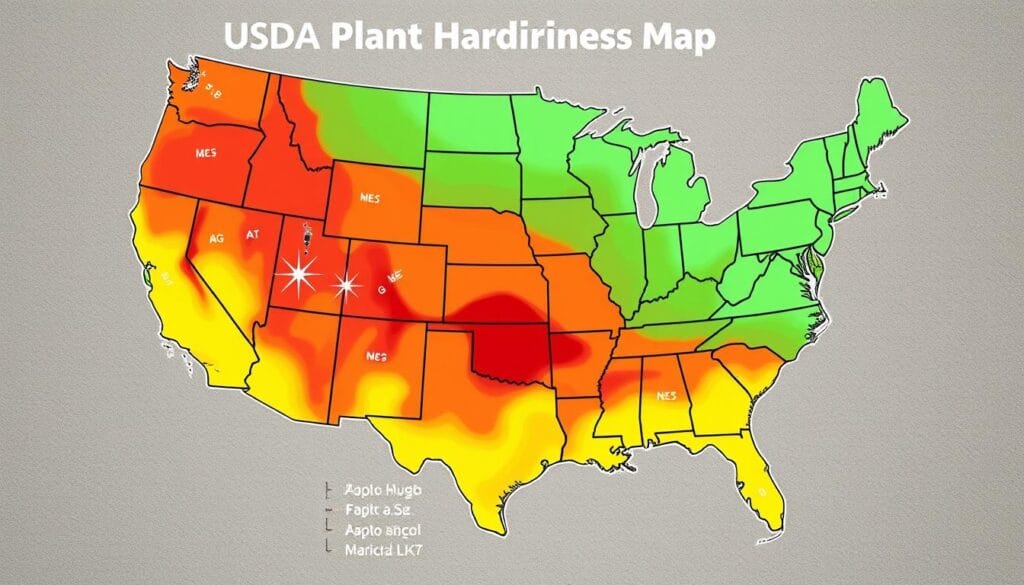
The 2023 plant hardiness map shows big changes from the 2012 version. Half of the U.S. has moved to warmer zones, thanks to climate change. This means more plants can grow in different areas.
The USDA Hardiness Zone Map is very useful for gardeners. It helps them pick plants that will do well in their area. By knowing their zone, gardeners can create beautiful, lasting gardens.
How Temperature Affects Plant Survival Rates
Temperature is key for a plant’s survival and growth. Knowing how temperature impacts plant hardiness is vital for gardening and landscaping. Factors like minimum temperatures, temperature changes, and seasonal patterns all affect plant survival.
Minimum Temperature Thresholds
Every plant has a minimum temperature it can handle without damage. Plants vary in their low-temperature tolerance. Cool-season crops like spinach do well in cold, while warm-season plants like tomatoes need warmth.
Temperature Fluctuation Effects
Temperature fluctuations also impact plant extreme weather resilience. Sudden temperature changes can stress and damage plants. For example, woody plants in temperate zones prepare for winter with hormonal changes.
Seasonal Temperature Patterns
Seasonal temperature patterns are crucial for plant survival strategies. Plants adapt to specific climates. Knowing local temperature changes helps gardeners choose the right plants.
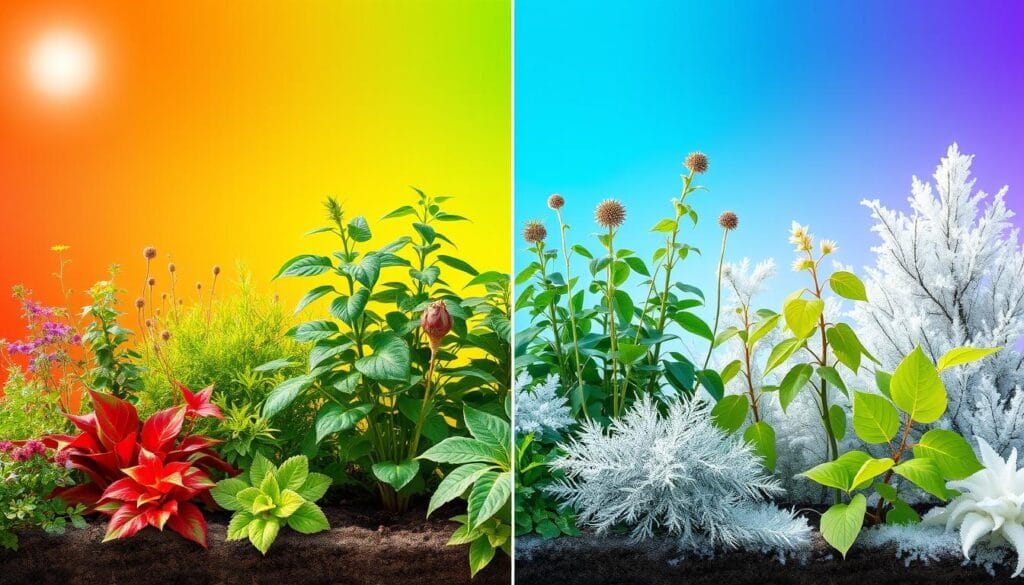
“Plants aim to reach an optimal temperature, balancing air temperature, relative humidity, and light levels for efficient growth.”
Understanding temperature factors helps gardeners choose and care for outdoor plants. Knowing about minimum temperatures, temperature changes, and seasonal patterns ensures a garden’s success and resilience.
Understanding Zone Classifications from 1 to 13
The USDA USDA hardiness zones split the United States into 13 areas. Each area has its own average winter temperature. These plant zone ratings range from Zone 1, where it can get as cold as -60°F, to Zone 13, where it rarely gets below 70°F. Knowing these cold hardiness zones helps pick plants that grow well in your area.
In colder zones like 3-4, you can grow hardy plants like conifers and kale. As you move to warmer zones, you can grow more plants. For example, in Zones 5-8, you can grow tomatoes and squash. In the hottest zones, 9-11, you can grow plants like succulents and okra.
The USDA Hardiness Zone Map, updated in 2012, is key for gardeners and landscapers. It helps gardeners choose the right plants for their area. This ensures plants grow well and live long.
The USDA system also has “a” and “b” zones within each area. These show a five-degree temperature difference. This helps gardeners pick the best plants for their exact area. By using the USDA Map and other tools, gardeners can create beautiful, lasting gardens.
Hardiness of Plant Example: A Comprehensive Guide
Understanding plant hardiness is key for a successful garden. The plant hardiness zones help you choose the right plants for your climate. Let’s explore a detailed guide on plant hardiness.
Cold-Hardy Plant Species
Not all plants can handle cold well. Plants in Zones 3 and 4 are cold-hardy and can survive harsh winters. For example, foxglove and smooth hydrangea can handle temperatures as low as -40°F to -30°F.
Frost-Resistant Varieties
Some plants are also frost resistant. Many conifers and perennials can handle frost and light freezes. It’s important to pick the right frost-resistant plants for colder areas.
Zone-Specific Plant Selection
Choosing the right plants for your zone is crucial. For example, Zone 7 plants like crape myrtle and Southern magnolia can handle 0°F to 10°F. Zone 10 plants like bougainvillea and royal palm can tolerate 30°F to 40°F.
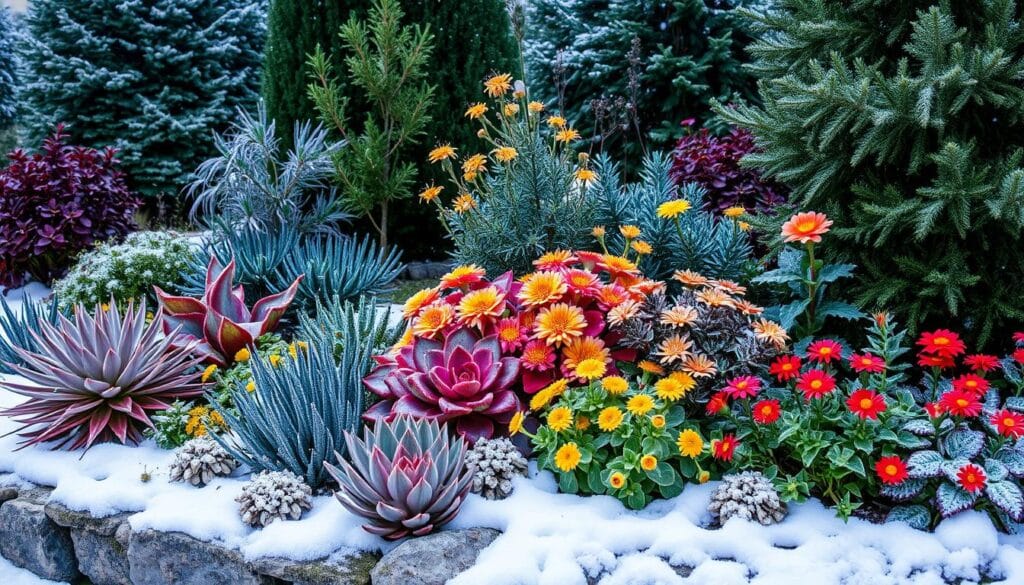
“Understanding plant hardiness is essential for creating a thriving garden that can withstand the challenges of your local climate.”
By picking plants based on their hardiness zones, gardeners can help their plants thrive. This ensures they can survive and grow well in their environment.
Beyond Temperature: Other Factors Affecting Plant Hardiness
Temperature is key in figuring out if a plant can survive. But, other things like soil, humidity, and wind also matter a lot. These factors help plants adapt and handle stress better.
The Sunset climate zones system looks at more than just cold. It also checks the growing season, summer heat, rain, and humidity. These things help decide if a plant can do well in a certain area.
Knowing how to care for plants can help them thrive, even in tough places. By picking the right plants for their needs, gardeners can boost their chances of success.
Exploring Beyond Temperature
While temperature is important, other things matter too. These include soil, humidity, wind, growing season, summer heat, and rain. All these microclimate factors help plants adapt and resist stress.
- Soil drainage and moisture levels
- Humidity and wind exposure
- Length of the growing season
- Summer heat and rainfall patterns
By thinking about these factors, gardeners can pick the best plants for their area. This leads to healthier, more resilient gardens.
The Sunset Climate Zones Approach
The Sunset climate zones system is used in the western U.S. It looks at more than just cold. It considers things like growing season, summer heat, rain, and humidity.
| Factor | Importance |
|---|---|
| Growing Season Length | Determines the time frame for plants to complete their life cycles |
| Summer Temperatures | Affects heat tolerance and water requirements |
| Rainfall Patterns | Impacts soil moisture and drought resistance |
| Humidity Levels | Influences disease susceptibility and water loss |
This system helps gardeners pick the right plants for their area. It considers the local microclimate conditions.
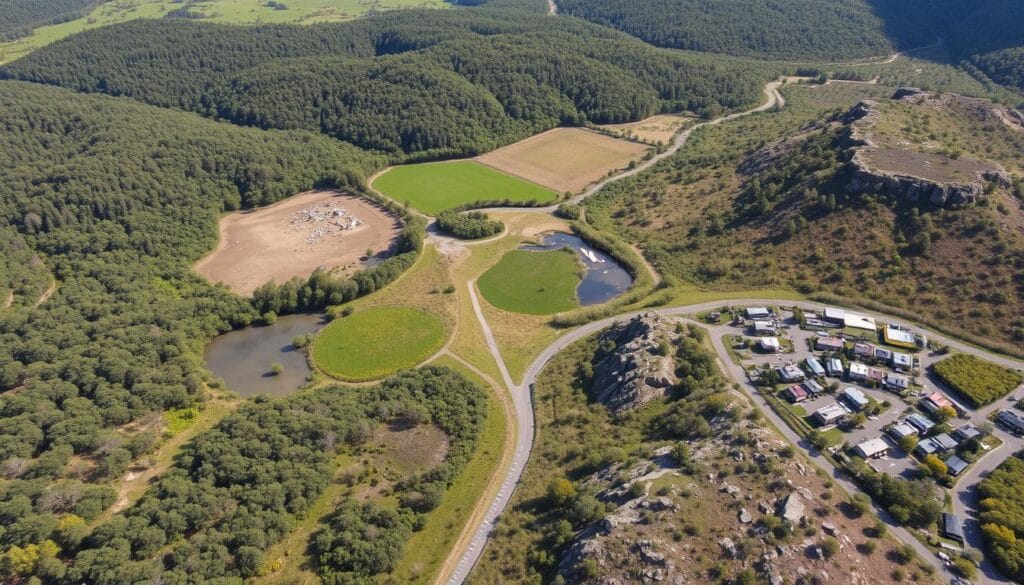
“Sustainable gardening practices, such as planting native species and avoiding chemicals, can significantly enhance biodiversity, improve soil quality, and conserve water.”
Microclimates and Their Impact on Plant Growth
Gardening fans need to look beyond just plant hardiness zones. They must understand the unique microclimates that affect plant growth. These small environments, shaped by urban areas, landscape, and weather, are key to a garden’s success.
Urban Heat Islands
In cities like Philadelphia, urban heat islands make areas warmer than suburbs. The lots of concrete and buildings in cities trap heat. This can affect which plants grow well and how long they live.
Landscape Features
The shape of your garden can create different microclimates. Walls or slopes can hold heat longer, while shaded spots are cooler and wetter. Raised beds warm up fast but dry out quicker. Low spots collect cool air and moisture, perfect for plants that love water.
Local Weather Patterns
Local weather, like wind and rain, shapes microclimates too. In Arizona, plants that need full sun thrive in areas with six or more hours of direct sunlight. Wind can dry out plants, affecting what you can grow. Knowing this helps gardeners choose and place plants wisely.
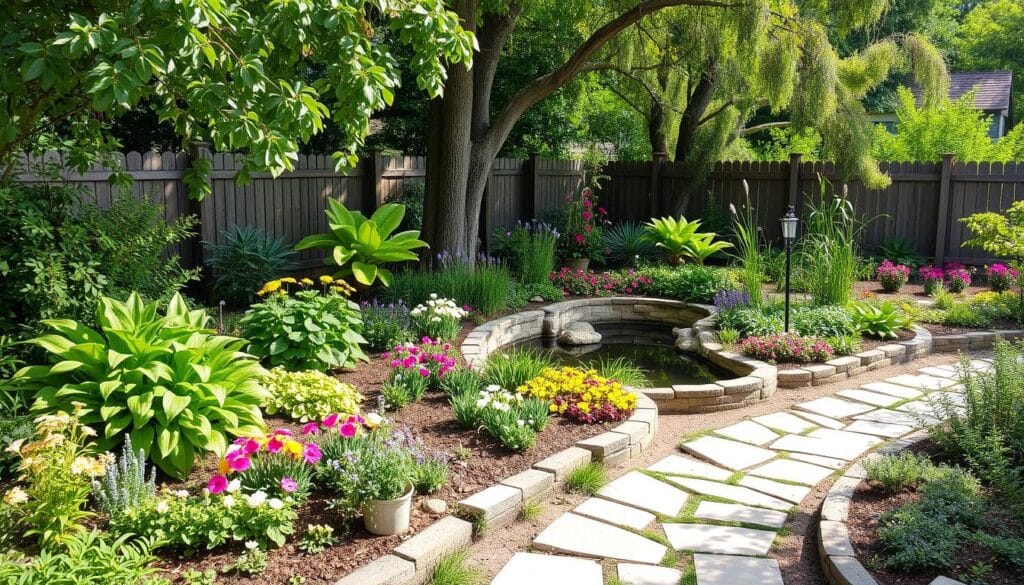
By understanding and working with your garden’s microclimates, you can make the most of microclimate gardening and urban gardening. Paying attention to local climate factors and testing soil can help you pick the right plants for each spot.
Adapting to Climate Change: Recent Zone Map Updates
The 2023 USDA Plant Hardiness Zone Map shows the harsh reality of climate change. Many areas in the United States have moved to warmer zones. This change lets gardeners grow plants that were once too cold for their area.
In Philadelphia, the city has moved from Zones 7a and 7b to solidly 7b. Parts of Delaware County have moved to 8a. This means gardeners can now grow plants like camellias and crepe myrtles.
The data is striking. 95% (231 out of 242 locations) across the contiguous U.S. saw average annual minimum temperatures rise by an average of 3.3°F since the 1951-1980 period. Also, 50% of the 242 locations experienced an increase in their plant hardiness zones during the analysis period.
Reno, Nevada, saw the biggest temperature jump at 9.3°F. Anchorage, Alaska, and Las Vegas, Nevada, also saw big increases. These changes allow for growing plants once only found in warmer areas.
Gardeners and landscapers must adjust to these changes. By keeping up with the USDA Plant Hardiness Zone Map, they can choose plants that thrive in their area. This ensures their gardens stay healthy and resilient.
The 2023 USDA Plant Hardiness Zone Map was released in November 2023. It uses data from 13,412 weather stations, more than the 7,983 from the 2012 map. This better data helps show how the climate is changing across the country.
“As the climate warms and precipitation patterns change, the impact on plants, plant communities, and ecosystems continues to be studied. Local genotype or local ecotype native plants are better adapted to local conditions and the needs of local pollinators.”
By keeping up with these changes, gardeners and landscapers can make their outdoor spaces thrive. They can adapt to the effects of climate change and ensure their gardens’ success.
Tips for Choosing Plants Based on Hardiness Zones
When picking plants for your garden, knowing your local hardiness zone is key. The USDA Plant Hardiness Zone Map splits the U.S. into 13 zones. Each zone has its own average minimum winter temperatures. This knowledge helps you pick zone-appropriate plants that will likely do well in your area.
First, find out your specific hardiness zone, which ranges from Zone 1 to Zone 13. Note the “a” and “b” subzones, as they greatly affect plant survival. Feel free to try plants from slightly warmer zones if your garden has a protected spot.
- Think about more than just temperature when choosing gardening tips. Consider soil type, sunlight, and moisture too.
- Keep up with updates to the USDA Plant Hardiness Zone Map. Climate change might have changed your zone.
- Be ready for sudden weather changes that could harm your plants. Adjust your plant selection guide as needed.
By grasping the details of hardiness zones and using this knowledge in your plant selection guide, you’ll create a garden that’s both beautiful and resilient. It will stand up to your local climate’s challenges.
“Successful gardening is all about choosing the right plants for your specific growing conditions.”
Common Mistakes in Plant Hardiness Zone Selection
Gardeners face challenges when choosing the right plant hardiness zones. Mistakes can happen, affecting even the most passionate gardeners. These errors include misreading zone maps and ignoring local climate factors.
Misreading Zone Maps
One big mistake is misunderstanding hardiness zone maps. These maps are useful but don’t cover every detail. Gardeners should look beyond just the zone number and consider other environmental factors.
Ignoring Microclimate Factors
A garden’s microclimate can greatly impact plant hardiness. Things like sun, wind, and soil can change the local environment. Ignoring these details can lead to plants not doing well in your garden.
Seasonal Timing Errors
Even with the right zone, timing is key. Planting too early or late can harm plants. Gardeners need to know the best times to plant to help their plants thrive.


